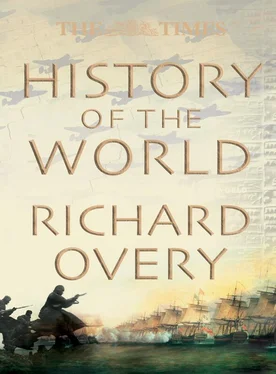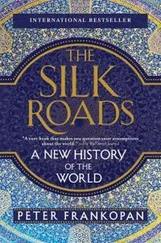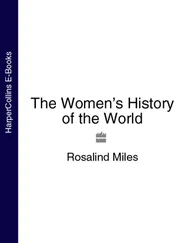TO 500 BC
THE BEGINNINGS OF INDIAN CIVILIZATION
India was the home of one of the oldest civilizations of history, which grew up along the banks of the Indus river. The Indus valley culture and the Vedic culture, which succeeded and was influenced by it, were the basis for the development of later Indian society, in particular for the major religious systems of Hinduism, Buddhism and Jainism.
The early history of India is very difficult to recover. Archaeology can reveal something about the way of life of its earliest inhabitants, but little can be learned from written evidence. The earliest works of Indian literature, the Vedas , were composed in the centuries after 1200 BC, but they were not written down until probably the 5th century.
HARAPPA AND MOHENJO-DARO
Although the subcontinent had substantial human occupation from the Stone Age onwards, the first great Indian civilization was the Harappan culture which emerged in the Indus valley in the 3rd millennium BC. Like the slightly older civilizations of Mesopotamia and Egypt it was based on flood-plain agriculture, as the cultivation of the fertile land on either side of the Indus was able to provide enough of a surplus to support a complex urban society. Several substantial cities were built, of which the best explored are Harappa and Mohenjo-Daro.
The Indus civilization also developed writing, and about 2000 seals with short pictographic inscriptions on them have been discovered. The script has not been deciphered, and until it is, little will be known about the political structure or religious beliefs of the Indus civilization.
The presence of cylinder seals from Mesopotamia at Mohenjo-Daro and of Indus seals in Mesopotamia is evidence of trade between the two areas via the Persian Gulf, and tin and lapis lazuli from Afghanistan and Central Asia also made their way to the Indus. However around 2000 BC the ‘Harappan period’ came to an end, as the cities ceased to function and were replaced by a settlement pattern of agricultural villages and pastoral camps.
POST-INDUS INDIA
From around 1500 BC a new culture becomes apparent in India, characterized by a new language and rituals, and the use of horses and two-wheeled chariots. The traditional way to explain the changes was to talk of an “Aryan invasion”, with mounted bands of warriors riding in from the northwest and conquering the indigenous Indus population before moving eastwards to the Ganges. Support for this picture was claimed from one of the Vedas, the Rig Veda, where the Aryans are presented as conquering the cities of the darker skinned indigenous Dasas. Archaeological evidence offers little support for this theory however. The styles of pottery associated with the Indo-Aryans, known as Painted Grey Ware, which appears from c. 1100 BC, is similar to earlier Painted Black and Red Ware, and this may indicate that Indo-Aryan speakers were indigenous to the Indus plain. Whatever their origins, Indo-Aryan languages, from which Sanskrit developed, became widespread through Northern India.
THE SOUTH
Southern India was left largely untouched by the civilizations of the north. There were probably trading links between the Indus valley and the southern tip of the peninsula, but there was no urbanism in the south, where villages were the normal form of social organization. However, some limited form of common culture in the south is suggested by the distinctive megalithic tombs found over most of the area.
In the north, where, unlike the hilly, fragmented geography of the south, great plains lent themselves to large-scale agriculture and the growth of substantial kingdoms, cultural coherence became more widespread as, in the period after 1000 BC, the new civilization spread gradually east from the Indus to the Ganges. Evidence from finds of pottery characteristic of particular periods suggests that there was also movement southwards. The late Vedic texts depict the early first millennium BC as a period of frequent warfare between rival tribal territories. During this period the society of Northern India became increasingly stratified, and this culminated around 600 BC in the emergence of states ruled by hereditary monarchs. Trading networks developed, agricultural activity increased, and this led to a new phase of urbanism in India. Once again cities began to be built, although they were not on the scale of Harappa and Mohenjo-Daro, being constructed largely from mud-bricks. No known public buildings survive from this period. Yet by the 5th century BC there were political entities that might be called states or polities, most significantly Magadha, with its substantial fortified capital at Pataliputra ( see p. 69).
VEDIC RELIGION
Religious practices in India in the first millennium BC were influenced in part by the earlier culture of the Vedas, and animal sacrifice had a central role in it. The religion was polytheistic, and the Rig Veda includes hymns to a number of deities, including the warrior god Indra, the fire god Agni, and Soma, identified with a mind-altering drug of some kind, possibly derived from mushrooms. These cults were the forerunner of Hinduism, and the urban societies that developed along the Ganges were the communities among whom appeared in the 5th century Mahavira, the founder of Jainism, and the Buddha himself.
c . 3000 TO 950 BC
MINOAN AND MYCENAEAN CIVILIZATIONS
In the late 19th century, Heinrich Schliemann and Sir Arthur Evans unearthed the remains of previously unknown civilizations. Although the names of Troy, Mycenae and Knossos were familiar from the poems of Homer, the Bronze Age societies of the Aegean revealed by these excavations had much more in common with contemporary Near Eastern societies than they had with later Greece.
Substantial settlements appeared in mainland Greece and Crete by the end of the 3rd millennium BC. These were subsistence farmers, with households producing goods for their own consumption. The subsequent appearance in Crete of large stone-built complexes marked the emergence of a new form of social organization. There are some parallels between these “First Palaces” and Near Eastern buildings, and they are accompanied by other signs of such influence, including the appearance of a form of hieroglyphic writing in Crete. However, it is likely that local needs as much as outside influence determined the island’s overall development.
There is no agreed explanation for the later destruction of the “First Palaces”, but in their place the large complexes of the “Second Palace Period” emerged. These were not fortified, but they were the focus of the economic and religious life of the Minoan communities.
By 1700 BC Knossos had achieved a dominant position within Crete, and the palace there reveals much information about Minoan society. Surviving frescoes depict scenes of communal activity including processions, bull-leaping, dining and dancing. It is clear from Knossos and other palaces that Cretan society depended upon intensive agriculture—the palaces incorporate large storage areas where crops could be gathered for later redistribution to the population. Outside the towns, especially in eastern Crete, large “villas” had a similar role, and acted as processing centres for grape and olive crops.
The two hundred years of the Second Palace Period witnessed considerable destruction and rebuilding at a number of sites. The eruption of Thera in 1628 BC left its mark on sites in eastern Crete but otherwise appears to have had little long-term impact. More significantly, a little over a century later many Cretan settlements were widely devastated, possibly as a result of invasion from the Greek mainland.
MYCENAEAN GREECE
Mainland Greece did not share in the prosperity of Crete and the Aegean islands until after c. 1700 BC, when rich burials, especially in the “shaft-graves” at Mycenae and in tholos tombs, point to the emergence of a powerful warlike elite. After 1500 BC mainlanders, called Mycenaeans, appear to have been in control of Knossos, where the palace functioned for another century. It was only after then that palaces started to appear on the mainland. While they owed something to Minoan models, and, like them, acted as centres for agricultural storage and redistribution, they were fortified and less luxurious. The Mycenaeans spoke a form of Greek, and wrote in a syllabic script, Linear B, adapted from the still-undeciphered script in use in Crete, Linear A. Documents inscribed on clay tablets reveal a strongly hierarchical society, with the ruler ( wanax ) at the top, lesser lords below and the mass of the people at the bottom.
Читать дальше










